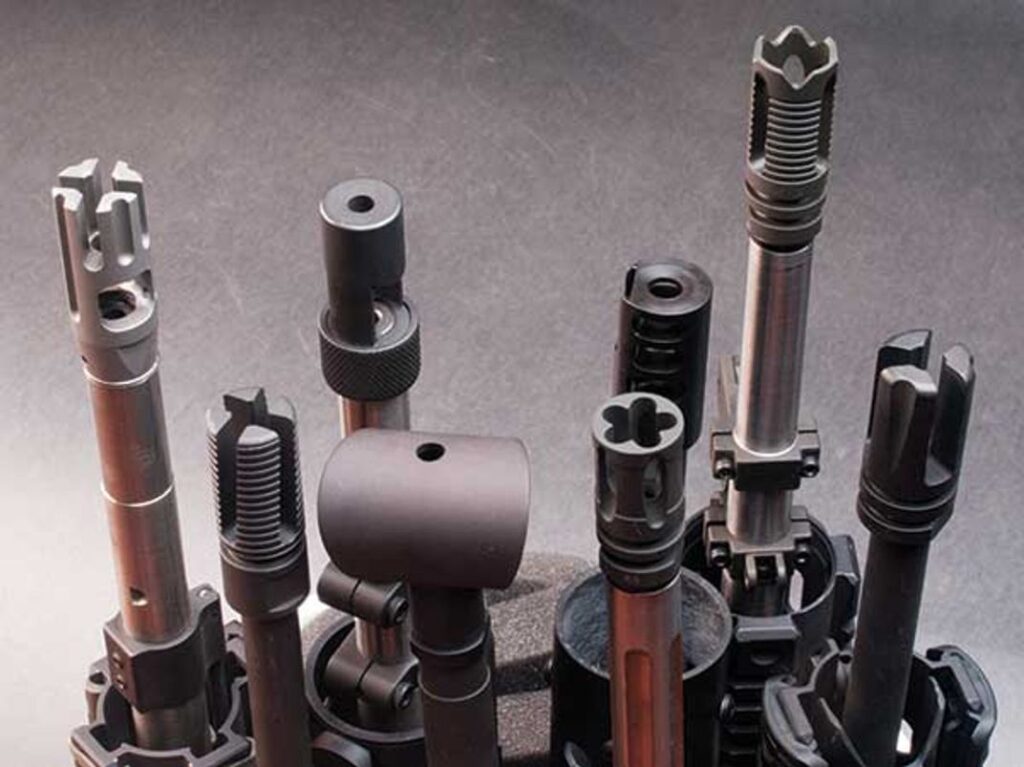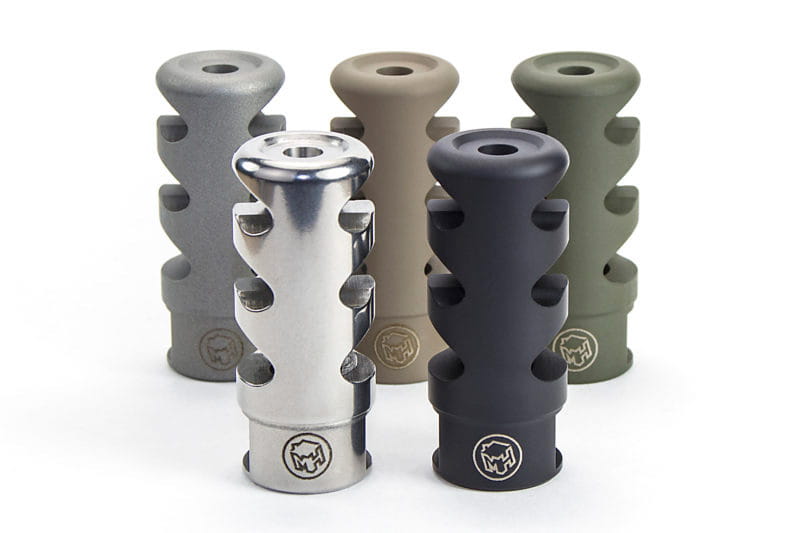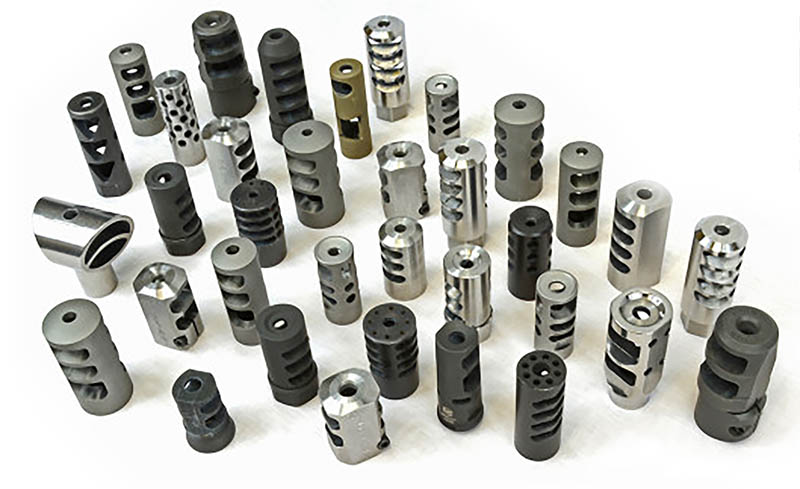Two different muzzle devices—muzzle brakes and compensators—help limit how much a rifle moves when it recoils. A muzzle brake is better for larger caliber guns and is designed to lessen the amount of recoil you feel when you fire. When the shot is fired, a compensator prevents the muzzle from rising off-target. Which is better for you, then? Please keep reading.
What Is A Muzzle Brake?
An accessory that attaches to the end of the barrel of a gun is called a muzzle brake. The main distinguishing feature of a fired round, despite variations in construction, is a series of cuts that aim the muzzle blast and burning gases away from the shooter, typically to the side or 180 degrees from the muzzle itself.
Pros
- Great in recoil reduction
- It can be a flash hider
- Lessen felt recoil
- Reduces gas blowback
- Can reduce muzzle rise
Cons
- Can be costly
- Loud
What Does A Muzzle Brake Do?
This effort is mainly made to lessen recoil because the majority of felt recoil from a firearm originates at the muzzle. This leads to additional advantages of muzzle brakes, as the shooter may be more accurate and may be able to fire more quickly after releasing the muzzle brake.
When coupled with a suppressor, some muzzle brakes can serve as a sacrifice blast baffle. This is not the same as a sound baffle, which lessens the gun’s audible signature; rather, the brake absorbs more of the muzzle blast and fired gasses than the suppressor’s internal baffles do. This usually increases the suppressor’s lifespan.
The disadvantage of most muzzle brakes is that they can alter the direction in which the fired round makes its sound. Although the shooter may occasionally perceive the sound of the weapon as louder, other shooters nearby will typically perceive the shots fired as louder.
In most cases, rather than being caused by the sound itself, this is the result of the other parties sensing the shockwave that was produced.
Muzzle brakes were initially designed to be used with cartridges that produced a lot of felt recoil; they were frequently found on belted magnum rifle cartridges used for hunting big game or dangerous game as well as bolt-action pistols chambered in 308 Winchester and 30-06 Springfield for handgun hunting.
They have nevertheless been successfully employed on rifles where a muzzle brake would have been unusual even ten years ago, proving that this is not always the case.
Competent long-range shooters frequently prefer muzzle brakes because the redirected gas and flash help them maintain a better line of sight. Muzzle brakes are popular with three-gun shooters because they facilitate quick follow-up shots and reduce recoil impulse.
What Is A Compensator?
A muzzle device known as a compensator operates differently from a muzzle brake. A compensator’s primary role is to reduce “muzzle flip” or “muzzle climb.” While some manufacturers assert that their products help reduce recoil, most compensators work on a different principle, so this claim is not entirely accurate.
Pros
- Keeps muzzle stable
- Mitigates muzzle rise
- Faster follow-up shots
- Enhanced precision
- Help reduce recoil
Cons
- Loud
- Not a flash suppressor
What Does A Compensator Do?
To prevent the firearm from rising during the firing sequence, the majority of compensators divert gasses and muzzle blast downward.
The Cutts Compensator, which can be found on the Thompson submachine gun, was one of the first compensator designs. The Cutts Compensator kept the guns on target when the 45 ACP round was fired in full auto because the recoil caused the muzzle to rise.
The same idea was applied to competitive pistol shooting in the late 1970s. A compensator’s ports are specifically machined and angled to force the pistol downward. Competitor pistol shooters were able to hit their targets more than once thanks to this ability to fire quickly and accurately.

After a while, the compensator returned to rifles, primarily semi-automatic modern sporting rifles (MSR), as the benefit of less muzzle rise was recognized as a benefit in the world of competitive shooting.
A Closer Look At The Differences Between Muzzle Brake And Compensator
How It Works With Suppressors
Muzzle Brake
Hybrid muzzle attachments are intended to function similarly to suppressors, or what most people refer to as a silencer. While a brake works wonders for reducing the impulse and muzzle blast of a rifle, it is not a very effective suppressor or silencer.
They incorporated them to provide more beneficial functionality when connected to firearms because of each tool’s limitations.
With a suppressor or silencer, it is challenging to locate the source of the sound. As the impact leaves the tool’s chambers and exits through the holes, it is contained. Considering that a regular brake has designs where the flames come out at the end of the barrel, a flash suppressor and muzzle brake make a good combination.
The shooter’s sight will not be on the target in the absence of a suppressor on the muzzle device. When shooting on the range, accuracy is more important than sound suppression because a more accurate target is more effective.
Compensator
The advantages of using this tool with a suppressor on a rifle are also advantageous. Although it is not its best quality, drawbacks can be very helpful in preventing muzzle flips. If the shooter can keep the muzzle down, you can fire more rounds.
Tanks and other types of artillery operate similarly to a compensator. Because the sound will be projected in the direction that the holes on the mechanisms are facing, silencers, particularly those used by the military, will not reveal their location.
A flash suppressor cools down the gasses to mask the firearm’s signature while a compensator already addresses muzzle climb. Nevertheless, since not all muzzle devices are designed to be flash hiders, improving this feature can be very advantageous.
The only option for this device is to use a flash hider when the shooter fires his rifle at night. He can maintain his accuracy and fire subsequent shots without incident in this way.
Mounting Options
Muzzle Brake
The installation of a muzzle device or a silencer on a rifle is not thought of as a simple task. There is typically a threaded barrel, so you have the option to look for the required washers to ensure the required fit.
Before selecting the muzzle device you intend to use, it would be beneficial if you took into account your rifle’s caliber and thread pitch. Naturally, they are built on the inside and each one is a specific length.
It is typical to find threads at the end of the rifle’s barrel, but the pitch of those threads varies, which leads to complications. As a result, you must use washers, crushers, and peelers when installing your muzzle brake.
The gun’s caliber and ammunition should be taken into account by the shooter. Additionally, the internal diameter from which the shot is emerging will be more significant.
Compensator
Installing a compensator is very similar to installing a silencer or a muzzle brake on a rifle. You can mount this and the jam nuts on a gun while it is lying down.
Other nuts and washers guarantee that the compensator fits your rifle or other weapons of choice perfectly. Every caliber and type of firearm has a specific size. It serves this purpose that the holes are positioned where they are in the device tips.
It would be wise to grease the tool before mounting it if you are unsure of how long you will be using it on your rifles. However, once you’ve made up your mind, taking it out of your weapon won’t be a hassle.
Design And Material

Muzzle Brake
The type of weapon you have will determine the options you have for muzzle brakes when it comes to variety. Given that muzzle brakes are used by military-grade weapons, their construction must be robust. If not, when guns are fired, it will break.
A muzzle device is made of reinforced alloy or stainless steel. Some even finish with nitrate to add more years.
These are not meant to last for many years because they will give way after taking so many blasts. However, it would be wise to use it for a few rounds.
They are made with a strong outcome in mind due to their design, which aims to reduce recoil impulse. To reduce the impact, there are always holes on the side. If they pick the right brake, they can fire the rifles with a small jump.
Compensator
On the other hand, different kinds of materials can be used to create a compensator. The most popular are those made of stainless steel to withstand impact when firearms are fired.
Rubber and neoprene come in various types. Although they weren’t specifically designed for shortcomings, they must withstand muzzle blast. A grenade launcher also has equipment built specifically for them.
These tools have a remarkably similar build. In the machine’s body, they drill holes or, occasionally, slots. A design that has holes in all of its components won’t be visible on a rifle with a mechanism.
Instead, it will only be in the top portion to make sure that once the bullet is fired, the pressure remains at the bottom and does not rise.
Conclusion
For another day, we’ll talk about blast suppressors and diverters, which are more about noise. Recoil can be reduced by brakes, compensators, and ports, some of which are remarkably effective.
Muzzle brakes and compensators can improve your shooting experience, increasing comfort and control regardless of your level of experience with firearms. You should look into them and play around with both tools.
Read More:

